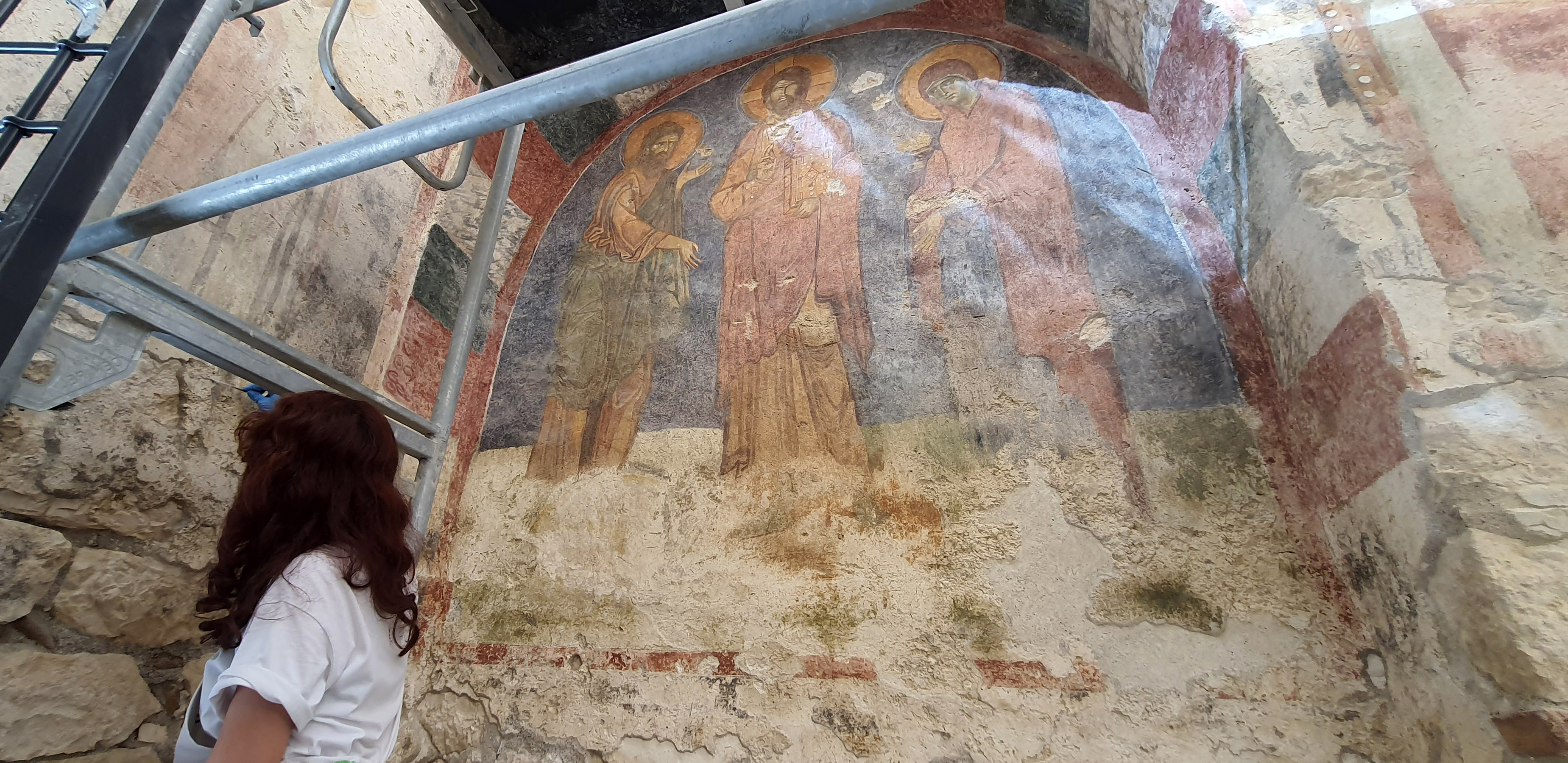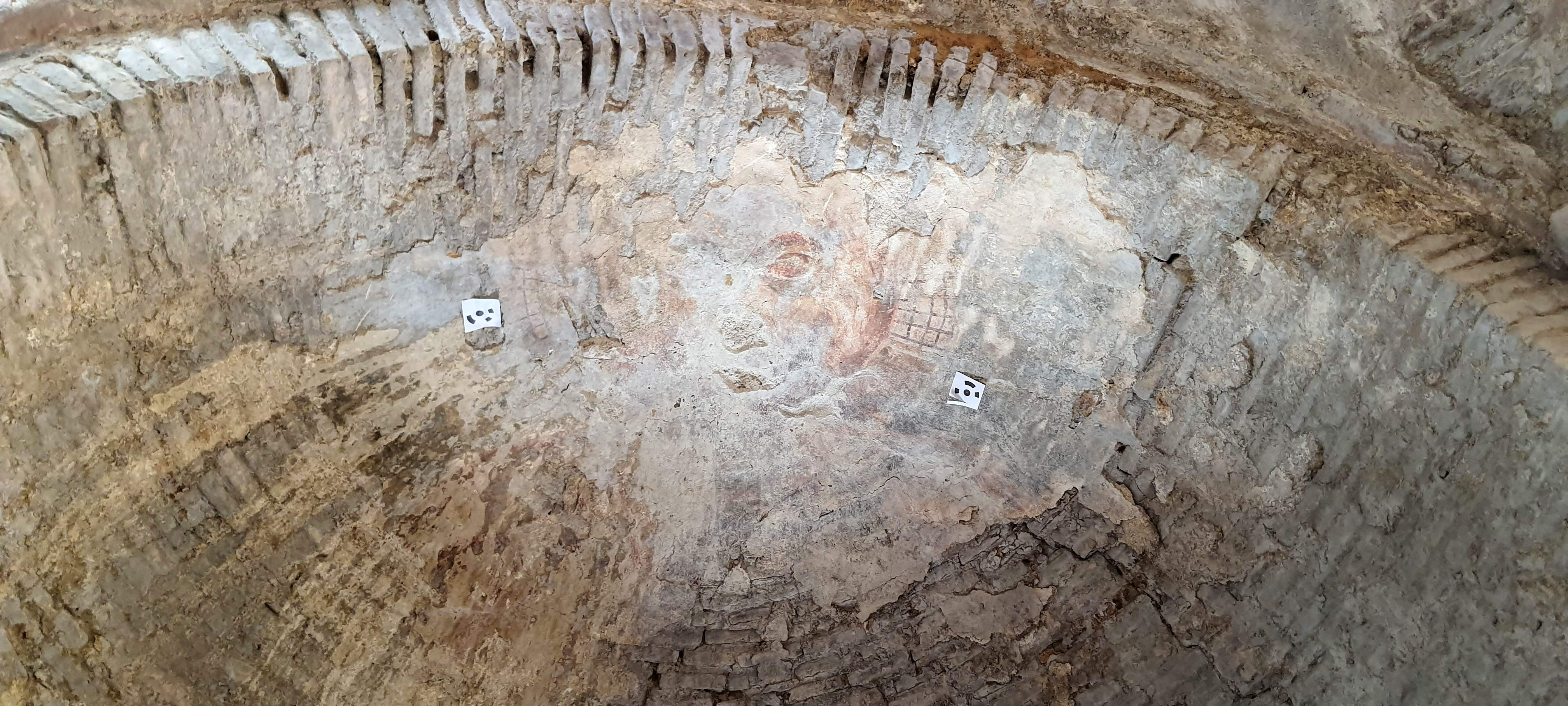
Antalya Cultural Heritage Preservation Regional Board, 'Santa Claus' in the church of St. Nicholas in Demre in 1850has thought to have been left unfinished by the Russians. The upper opening of the dome, Jesus determined that it was identical to the architecture in the Church of the Holy Sepulcher, where Jesus was crucified and ascended into heaven. Explaining that it is the most important discovery and finding regarding the exact location of his tomb, the Chairman of the Board, Prof. Dr. Osman Eravşar also said that the fresco of Jesus had been unearthed.
Antalya Cultural Heritage Preservation Regional Board President Prof. Dr. Osman Eravşar is the world's most valuable brand with a value of 1.6 trillion dollars. He announced discoveries of great importance in the church in Demre, named after St. Nicholas, known as 'Santa Claus', who was born and lived in Antalya, who is believed to drive the sleigh of deer and enter the chimneys of the houses and distribute gifts to the children. Chairman of the Board, Prof. Dr. Osman Eravşar pointed out that the church was built in the 7th-8th century over the early church of St. Nicholas. It was flooded with the rise of the sea during the Middle Ages. Eravşar said that the discoveries belonged to the early church. It was buried under alluvial deposits from the period when St. Nicholas lived.
Screed Floor Applied in 1970 Removed
Reminding that the restoration of the St. Nicholas Church, the project of which was approved in the past years, in the 'memorial museum' of the Ministry of Culture and Tourism, started this year, Eravşar said, "However, the project may change depending on the restoration, new information and findings. We have experienced this process in this structure and have been successful. "During the restoration, some repairs and renovations would be made, especially on the floor coverings of the church when this building was opened to visitors in the 1970s. Some parts of the ground were filled with mortar and corrected. These would be removed, and a more proper arrangement would be made by its technique," he said.
St. Nicholas' Footsteps
Point out that the church in the 3-4th century, where St. Nicholas lived, was buried 7-8 meters due to the rising waters in the Mediterranean and covered with alluvium. Eravşar said that the current church was built in the 7th-8th century and that the ground on which he stepped was reached. Eravşar stated that among (invisible creative power) was found in the naos (main) part of the church, whose existence they knew from a photograph in 1910, and said:
"This would be shown on the surface at least linearly. When the screed floor slab laid in the 1970s was removed, an excavation was carried out to find out what was in it. As a result, the church's early period, 4th-century floor covering, was revealed. The current church is dated later. There are some architectural traces in various parts of the early period building, but there were no traces in terms of flooring. This is a floor that was uncovered, maybe earlier. Our friends who excavated it are preparing a publication. This is the floor of the period he lived in, and it is highly probable that St. Nicholas we are talking about the floor paving on which the foot of. "
Most Important Discovery And Finding
Eravşar also announced that the most important discovery and finding had been reached regarding the determination of architecture similar to the Church of the Holy Sepulcher. It is believed to have risen from where Jesus was crucified and placed in a tomb in Jerusalem. In the Crusades of the 14th century, Bari merchants took the relics of St. Nicholas in the tomb (in Christianity, sacred objects or parts associated with or remained from Jesus, saints and saints) in this church and took the bones to Italy to sanctify their city. Eravşar, who stated that other relics were taken by the Venetians in the same period, explained the discovery as follows:
"At this time, the church was damaged. In other words, the tomb of St. Nicholas was probably opened, his bones were removed, and the coffin, is said to belong to him today. It was placed in a niche on the side of the chapel. Of course, the original place of this coffin is not there for me. It is probably another sarcophagus. "This must have been a special place inside the church. The most special place inside the chapel is a section with three apses covered with a dome. I think that's it, the middle part. And on the façade of the apse, there was a pantocrator Jesus (Jesus Christ)" The fresco (the scene in which he is depicted holding the Bible in his left hand and making a sign of blessing with his right hand) has been detected. This is also a new release. Therefore, this shows that this place is a special place."
Aperture Detail in the Dome
Chairman of the Board Eravşar spoke as follows about the opening in the dome:
"Again, in the restoration project, those who prepared the project and those who provided consultancy services told us that the middle of the dome in front of this apse is open and should be closed. However, we, as a committee, opposed this. Because there is a principle in restoration, restoration stops where the assumption begins. They stated that the Russians left it unfinished. There is no such thing, every part is completed, but a small part cannot be left unfinished. It was requested that this place be closed, but we did not find it appropriate, and we wanted it to be left as it is. In this section, where the dome's opening fell, the floor completely deteriorated and was interesting. There are also small galleries around it. Of course, as a result of this, I asked the question, 'What could this be?' and realized that a similar approach exists in the Church of the Holy Sepulcher in Jerusalem. There is an opening in part directly above the tomb. Or, on March 21, at the equinox, the light falling from the above space will fall vertically on the grave of Jesus Christ, and one of the Orthodox priests will enter the tomb and reflects the falling holy light onto the candle lights the candle, and then distributes that candle to the other chapel members. "
Same Ritual
Stating that he guessed that the ritual was similar to the Church of St. Nicholas, Eravşar said, "I think this open dome was also built for this purpose. The ground under the dome was damaged again. It was covered with a thick layer of mortar in the 1970s. There is no excavation there yet. But we see from the traces that there are Greek inscriptions around it. The inscriptions are only there on the ground. It points to us that this is a special place. So now it means something like this. The desire to be close to the holy temple, which started from Judaism and converted to Christianity, when the apocalypse breaks, is also here. That's why we think he was buried here. So it's very likely that this is where the tomb of St. Nicholas is located, and the ritual in the Church of the Holy Sepulcher was also here. I think this is an essential attribute of the Orthodox world. This is the most important discovery and finding." he said.
There Might Be Remains From 'Santa Claus'
Noting that some of St. Nicholas' relics are exhibited in Italy, and some of them are exhibited in Antalya Museum, Eravşar continued as follows:
"There are probably other bones that are said to belong to him, or at least other iconographic pieces may be found. Of course, the church has a special position today, and unfortunately, due to the sea level rise in the area, the early church is almost 2 meters below the sea code. It causes floods from time to time. As a result of the rising waters of the Mediterranean in this region, alluvium has filled the church. We do not know exactly how low it is. However, if a geophysical survey is done in this region, I think we can find it; that is also a question mark. Because geophysical studies have some distractions, one of them is moisture in the area. If there is intense moisture and water, no results can be obtained. In this case, the only thing we can do left is to excavate in that area. If the excavation heads do these in the future, this information will be revealed more concretely, and we have learned new things."
Sarcophagus Removed and Moved
Stated that they think that the coffin, decorated with fish scales and acanthus leaves inside the church and thought to belong to 'Santa Claus,' was displaced by the Barians in the 14th century when its relics were taken and moved to another area, Eravşar said, "Unfortunately, the most important damage is here, caused by the visitors. "Because it is considered sacred, he wants to tear off a piece. On the other hand, they light candles around this sarcophagus. His soot and oil are polluting these places. Again, cleaning works were carried out by their technique," he said.
Santa's Last Place
Saint Nicholas, known to the whole world as 'Santa Claus', was born in Patara. It is one of the important port cities of the period, which hosted the Lycian Union Parliament Building, in 300 AD, as the son of a wealthy wheat merchant. St. Nicholas passed from Patara in Kaş district to Myra in Demre district. He lived here for many years and served as a bishop. St. Nicholas Church in Demre is believed to have died as the Bishop of Myra at age 65 on December 6, 365. He has a very sacred value in the Christian world, especially for the Orthodox. Thousands of tourists visit this place every year. While there are frescoes belonging to St. Nicholas on the church's walls, there is also a coffin from the Roman Period decorated with fish scales and acanthus leaves, which is thought to belong to him. (Mehmet Çınar- DHA)




